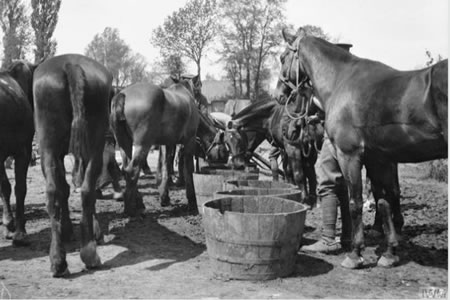“When leaving Dives on the morning of the 30th ‘A’ Squadron was detailed as rear-guard to the Regiment. The Squadron moved out at 4.30 a.m. and occupied the high ground north of the village; Taylor’s troop towards Lagny, Eliot’s three quarters of a mile south of it at the chateau, and Cahusac’s to the south-east of Eliot, Squadron Head-Quarters with Turner’s troop was at a farm near Eliot on the road. Squadron Sergeant-Major Burns and one man were left in Dives to report when the Regiment as rearguard to the brigade, retired.
“Soon after Burns’s personal report that Dives was clear Taylor reported an enemy troop supporting a patrol which he had driven back. I sent him word by his messenger to withdraw to the left of the Eliot-Cahusac line. This messenger, Shoeing-smith Bailey, delivered his message, but on the way ran into some German cyclists, and was wounded by revolver-shots. Giving the Regiment time to get well clear of Dives, the squadron fell back by Dreslincourt on to the main Noyan-Compiegne road, and thence to Ribecourt, Turner’s troop being sent farther up that road to cover my withdrawal.
“On the way I found Bell, with last night’s billeting party, just waking up, and I gathered him in. To the main road the squadron rode across country, and nearly missed its direction in a wood; after joining the main road Turner’s troop followed as rear-guard. Finding the tail of the Regiment just leaving Ribecourt, the squadron took up a rear-guard position to cover it, and then fell slowly back. At Longueil I got orders that the squadron was to remain out on outposts, possibly until the following morning. I had a look at the lie of the land, and posted Cahusac’s troop behind a small eminence about half a mile along the road to Coudun, with orders to patrol as far as Coudun. The remainder of the squadron was kept in Longueil. Observation posts were established, trenches dug across the street by civil labour, all approaches wired, and the horses with slackened girths placed in an orchard. The enemy reached Ribecourt during the afternoon. About 9 p.m. Eliot, who had missed the squadron at Ribecourt and found his way to the Regiment at Margny, arrived with his troop and the news that the whole Regiment was coming up to Coudun, and that the 1st Cavalry Brigade was on the other side of the Oiso on my right. Keeping Eliot’s troop with me, I sent Turner’s back to Janville on the Compiegne road.
“About 5 a.m. on the 31st a German cavalry patrol of six men came down the road from Ribecourt, in half-sections at a walk. My post opened fire and killed a horse. The dismounted Boche climbed up behind a pal and they all bolted. At about 7 o’clock a couple of enemy cyclists came to the crest of the high ground about a thousand yards in front of us, and remained there watching the village. I sent Eliot dismounted with four men to deal with them. Meanwhile a cavalry patrol of ten men came along the Ribecourt road. For the protection of Eliot we opened fire and the Germans bolted like rabbits. Not long after Eliot and his four men turned up. They had shot nine of the ten of the German patrol, by lying up off the road when they heard them galloping back. I sent Taylor’s troop out to get the identifications of the dead Germans. He came under fire before he reached them and lost a man, and, seeing the enemy in considerable force on the high ground, he withdrew. At the same time fifty Germans were reported in a hollow on my left front, with more coming on behind them. I sent Taylor’s troop, to a brick-field in that direction, and at 9.15 a.m. he became engaged. Two sections from Eliot’s troop were sent to reinforce him. Meanwhile, heavy fire was heard from Cahusac’s direction. Communication with him was now impossible, but I knew that he could get back by a track over Mont Ganelon (which he eventuality did).
“By 9.45 a.m. the enemy came on in increasing numbers. Up till now our opponents had been cavalry, but in a very short time infantry (possibly jager brought up in lorries) were to be seen advancing down the Ribecourt road. It was time to go, or run the risk of being cut off. Taylor’s troop, followed by Eliot’s, retired from the brick-field by sections at a trot, Squadron Sergeant-Major Burns remaining with the last section, which with rapid fire kept back the Germans. The leading attacking infantry were some 400 yards from the village as the squadron fell back, still covered by Burns and his section, who got away without any casualties. The squadron retired on Turner’s troop in Janville, which was quickly barricaded and put into a state of defence, and Olive was sent off to select our next position to retire to.
“He returned with the news that the 1st Cavalry Brigade on my right had withdrawn, and that the bridge in my rear over the Oise near Choisy was open, which would enable the enemy, who were pushing up the valley on the other side of the river, to get between me and Compiegne.
“At 11.30 a.m. I retired and passed through Compiegne, and eventually found our Brigade Headquarters with detachments of Carabiniers and Composite Regiment in a field on its north-west, and with them marched to Verberie, where I reported to the Regiment about 6 p.m. My casualties during the two days were three men wounded, who fell into the hands of the enemy, and Sergeant Randall and one man missing.”
Capt F.J. Du Pre, OC ‘A’ Sqn, 3rd Hussars


